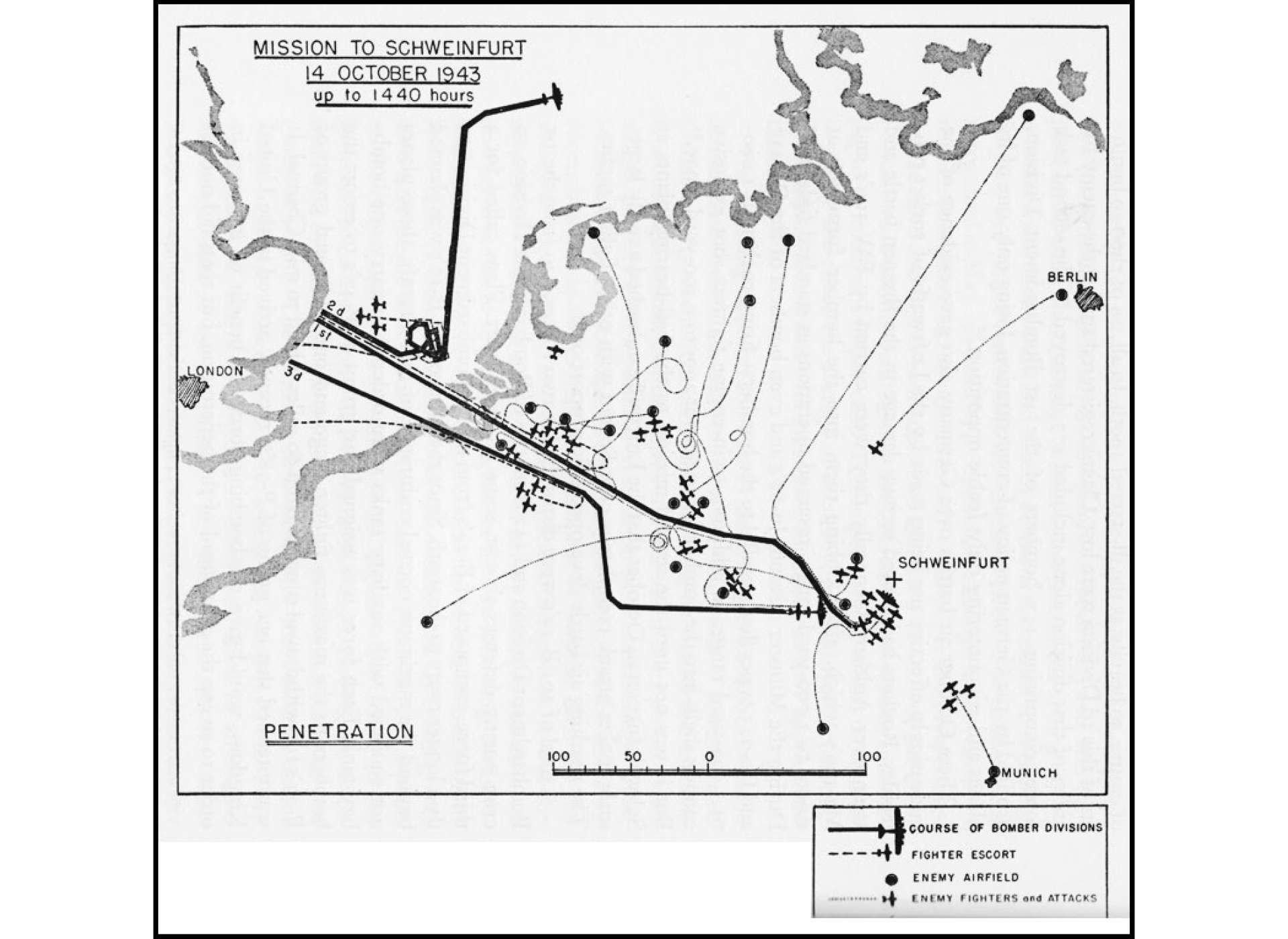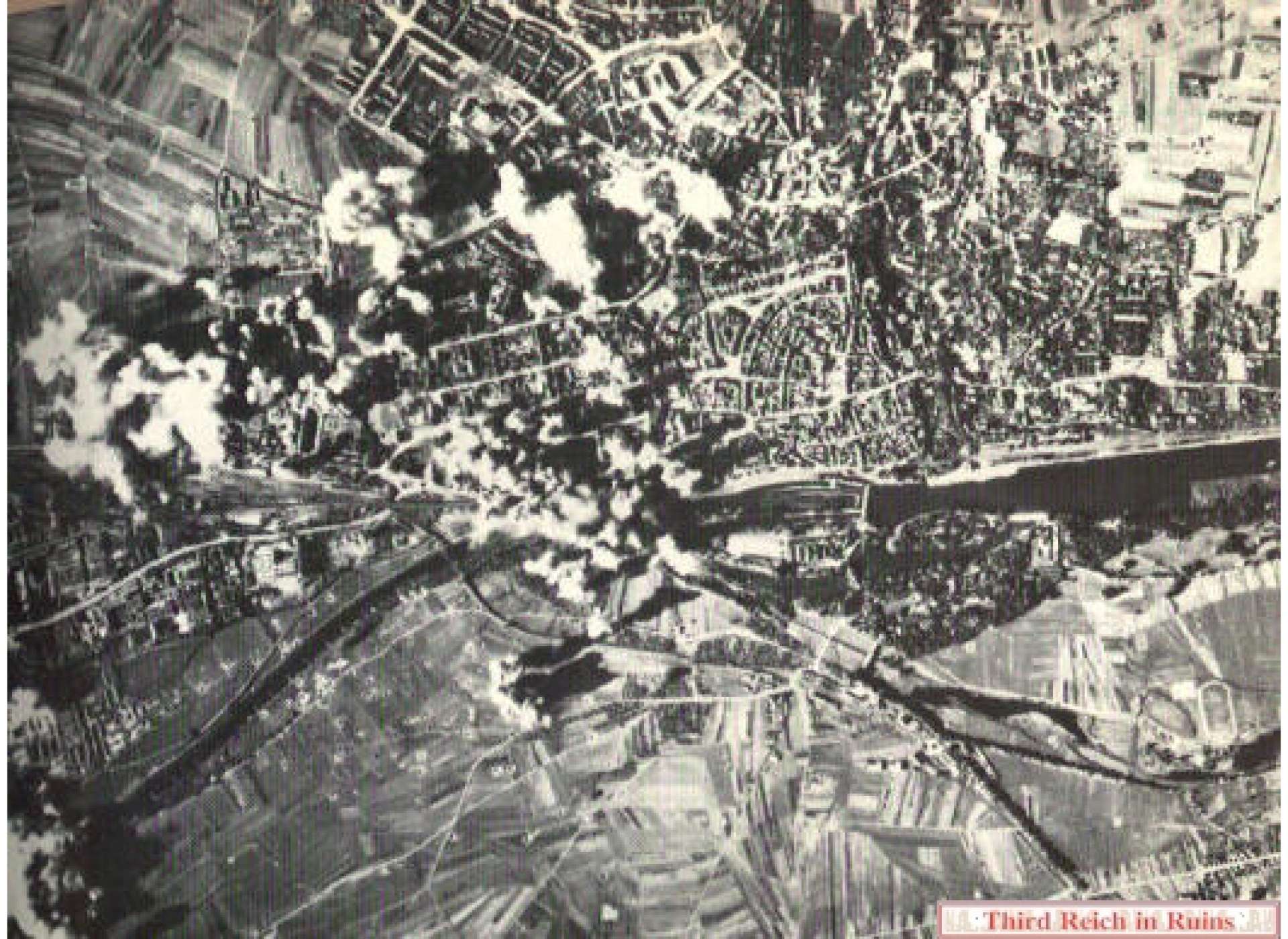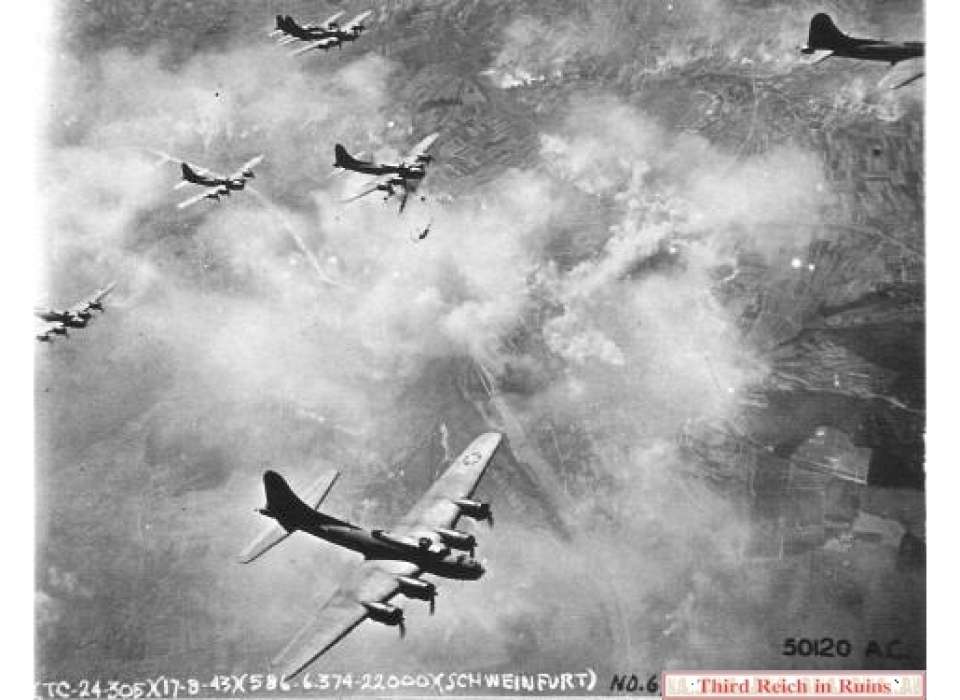Top image: B-17s of the 8th US Air Force in their combat formations over the Schweinfurt ball bearing complex. (National Archives photo)
The Combined Bomber Offensive (CBO) in the European Theater was one of America’s bloodiest campaigns. Operating from bases in the United Kingdom, the US Army Air Forces (USAAF) flew missions over occupied Europe alongside their Royal Air Force (RAF) counterparts from Bomber Command. The CBO sought to reduce German infrastructure and its capacity to support the Nazi war effort. The campaign also aimed to establish air supremacy over the continent in support of future ground offensives. Targeting factories, naval yards, airfields, and assembly facilities, the Allied air forces attacked German cities, production plants, and industrial areas. While the RAF executed area bombing at night, the Americans attempted precision attacks by day. In this three-year combined campaign, the U.S. 8th Air Force spearheaded the American bombing effort over Europe, but suffered more than 70,000 casualties.
In response to the Allied air offensive, the German Luftwaffe built a strong integrated air defense system with interceptor aircraft guided by ground based radar controllers. German ME-109, FW-190, ME-110, and JU-88 fighters attacked Allied aircraft as they flew over occupied Europe. Additionally, anti-aircraft artillery, or “flugabwehrkanone,” commonly referred to as “flak,” also targeted the Allied bombers. The Luftwaffe flak arm, eventually numbering over one million personnel, included thousands of 88, 105, and 128mm guns strategically located near potential targets or on recognized bomber routes. As the two sides clashed, the air war became a test of resiliency with the Luftwaffe and Allied crews locked in a high altitude battle of attrition.
Representing the ferocity of this aerial contest was a mission flown on October 14, 1943. In what became known as “Black Thursday”, the 8th Air Force’s 1st and 3rd Air Divisions flew from bases in East Anglia and attacked German ball bearing factories 400 miles away at Schweinfurt, Germany. Because much of the German war machine relied on low friction ball bearings, air planners believed that destroying ball bearing production would have a cascading effect upon the Nazi ability to wage war. While an earlier strike on Schweinfurt in August cost the USAAF 60 bombers, equaling 20 percent of the attacking force, the raid reduced bearing production by 40 percent. The Germans, however, quickly rebounded and the Allies scheduled a second raid.
Although the Americans initially believed they could fly bombers unescorted into enemy territory, this early phase of the air war provided some harsh lessons. Despite bristling with up to ten machine guns, the US B-17 and B-24 heavy bombers were constantly harassed by German defenses with American losses beginning to mount. Losses became so great that American aircrews would not, statistically, survive their required 25 mission combat tours. While realizing the need for fighter escort to protect the bombers, Allied pursuit aircraft in 1943 lacked the range to fly much past the French and Dutch coastlines.
As a result, the October Schweinfurt raid’s 291 bombers were escorted for only the first 200 miles of their trek. For the remaining 200 miles the bombers flew without any fighter protection. With the B-17s in their “combat box” formation approaching Aachen, the USAAF’s P-47 fighters reached the limits of their range of operation. Signaling their departure they wagged their wings at the B-17s in a friendly farewell, peeled off, and returned home. As soon as the American fighters left, the Luftwaffe struck.
Despite a failed attempt to create an aerial diversion using B-24s heading to the North Sea, the Germans tracked the American primary B-17 formation with radar the moment it took to the air. As the P-47s cleared the area, radar guided German fighters came at the bombers. Single engine German fighters, three and four abreast, attacked head-on at American formation and fired 20mm cannons at close range. This first wave was quickly followed by a second consisting of heavy twin engine JU-88 fighters. The larger fighters not only fired heavy bore cannons, but also 21cm rockets launched from beneath their wings. Firing these projectiles from up to 1,000 yards away, the JU-88s could safely remain outside the effective range of the bomber’s defensive guns. Packing considerable explosive firepower, a single rocket could easily destroy a bomber in only one salvo. Shooting rockets at the lead bomber, the JU-88s forced the American formation to break up as individual B-17s conducted evasive action.
Such tactics ruined the American formation’s mutually supporting defensive fires. The Luftwaffe coordinated their attacks effectively as they focused on individual groups within the formation. Overwhelming the unit’s defensive capabilities, the Germans then turned on the damaged stragglers that fell out of the defensive bomber formation. What made matters worse for the USAAF was that Luftwaffe crews flying from their home bases had time to land, refuel, rearm, and sortie again. This process would continue as the bomber formation flew to and from the target area.
By the time the Americans approached Schweinfurt, their formations had already lost 28 planes. With the 1st Bomb Division in the lead, crews of the trailing 3rd Division reported that their path to the target was easily marked by the smoke and fire of downed B-17s from preceding formations. Before reach the target the 40th Bomb Group, already lost seven of 49 planes with many others damaged. As the bombers reached the “initial point” and started their bomb runs, German aerial attacks abated.

Inbound trek of the Second Schweinfurt Raid on August 14, 1943. German fighters attacked the American formations once the American fighters reached their operational range. (US Air Force)
The absence of enemy fighters along with clear weather was welcomed, but Luftwaffe flak guns now engaged the formations. Aircrews avoiding direct hits could still hear the sound of shrapnel as it penetrated or ricocheted off their bomber’s thin aluminum skin. While gunners could shoot back at pursuing fighters, there was nothing to be done regarding the flak. They had to ride through the barrage. Despite the mauling the formations took, their bombs accurately struck the ball bearing complex. Surviving aircraft of the 40th Group dropped 53 percent of their bombs within 1,000 feet of the aim point. Of the 1,122 high-explosive bombs dropped, 143 landed on the factory area with 88 direct hits. Despite the accuracy of the raid, however later analysis eventually determined that German ball bearing production dropped by a mere 10 percent.

Strike photo of the October 14 Schweinfurt mission. Despite accurate bombing ball bearing production dropped only 10 percent. (National Archives photo)
Having successfully delivered their payloads, the bombers now faced the same dangers on their return home. German fighters again pressed their attacks with one airman claiming:
“…never had we seen so many Germans in the sky at one time and never had their attacks seemed so well coordinated…wherever one looked in the sky there were Germans attacking, and B-17s smoking, burning, and spinning down.”
The Luftwaffe continued its attacks until the bombers reached the English Channel. Eventually the surviving bombers lumbered to England, with many landing at the first airfield they could find while some put down in the first level ground available.
By the time the Americans returned home, they had lost 60 B-17s, another 17 were no longer airworthy, and an additional 121 received minor damage. That was only the material loss. The number of aircrew killed, wounded, or missing in action was more than 600, totaling almost 20 percent of the men sortied. These grim numbers were double what 8th Air Force planners consider an acceptable loss rate. While gunners in the bombers claimed 186 Luftwaffe fighters downed, 27 “probable”, and another 89 damaged, such tallies were wildly inflated. Many men often claimed credit for the same fighter passing through a formation with other claims mere wishful thinking. For that date, German records revealed a loss of only 31 fighters destroyed, 12 written off and 34 damaged—hardly what the Americans claimed.
At the time, USAAF leaders lauded the effect and claimed victory despite the high American loss rate. 8th Air Force commander Lieutenant General Ira Eaker pronounced, “We now have our teeth in the Hun Air Force’s neck…,” but such a claim was pure canard and wildly inaccurate. While USAAF leadership publically declared success, privately they expressed deep concern over the losses as morale of 8th Air Force dropped. The reality was that deep penetrations into Germany without fighter escort were too costly. For the rest of 1943, the 8th Air Force limited its attacks to France, the European coastline, and the Ruhr Valley where fighter escort was possible.
Air planners avoided similar raids deep into Germany until the P-51 “Mustang” fighter with its extended range, excellent maneuverability, and ample armament became operational. However, the experience of “Black Thursday” had a lasting effect not only on the men and the planes, but it also made the USAAF reassess its theory of daylight strategic bombardment. Winning the air war would require new doctrines, equipment, and take much of 1944.
By Military Historian Dr John M Curatola LtCol USMC (Ret)
Cite this article:
MLA Citation:
APA Citation:
Chicago Style Citation:




![Max Fuchs, New York City cantor, sings as Rabbi Sydney [sic] Lefkowitz, Richmond, VA, conducts the first Jewish services from Germany.](/sites/default/files/styles/max_650x650/public/2025-10/image1.jpg)



